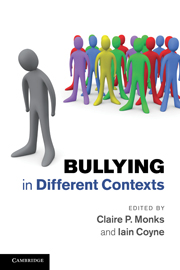Book contents
- Frontmatter
- Contents
- List of figures
- List of tables
- Notes on contributors
- 1 A history of research into bullying
- 2 Peer-victimisation in preschool
- 3 Bullying in schools: thirty years of research
- 4 Peer violence in residential children's homes: a unique experience
- 5 Domestic violence: bullying in the home
- 6 Juvenile dating and violence
- 7 Bullying in prisons: bringing research up to date
- 8 Bullying in the workplace
- 9 Elder abuse and bullying: exploring theoretical and empirical connections
- 10 Cyberbullying
- 11 An overview of bullying and abuse across settings
- Index
- References
4 - Peer violence in residential children's homes: a unique experience
Published online by Cambridge University Press: 05 June 2012
- Frontmatter
- Contents
- List of figures
- List of tables
- Notes on contributors
- 1 A history of research into bullying
- 2 Peer-victimisation in preschool
- 3 Bullying in schools: thirty years of research
- 4 Peer violence in residential children's homes: a unique experience
- 5 Domestic violence: bullying in the home
- 6 Juvenile dating and violence
- 7 Bullying in prisons: bringing research up to date
- 8 Bullying in the workplace
- 9 Elder abuse and bullying: exploring theoretical and empirical connections
- 10 Cyberbullying
- 11 An overview of bullying and abuse across settings
- Index
- References
Summary
Until recently, the issue of peer violence in residential children's homes has been largely absent from the official, professional and academic agenda. This is despite the fact that young people in care have consistently highlighted it as one of their overriding concerns. This chapter seeks to provide insights into the incidence and nature of peer violence in residential children's homes. Initially the international research evidence on peer violence in residential welfare settings will be considered. Following this, research undertaken by the current author and colleagues will be presented, which is, as far as we are aware, the first study to focus exclusively on the problem of peer violence within residential children's homes. Based on in-depth interviews with over 140 young people and professionals from 14 different residential settings, the research was able to capture the impact that peer violence had on young people's residential lives. Patterns of peer violence unique to this environment are documented. In conclusion, a range of residential policy and practice responses, based on empirical findings, are presented.
Background
It is difficult to provide an accurate account of how many children and young people experience living in a children's home. Neither the UK nor, for example, the USA, can provide systematic information on the number of children in residential care (Little et al., 2005). In March 2007, there were some 65,000 children and young people looked after in the UK; 10,000 were in residential care on any one day.
- Type
- Chapter
- Information
- Bullying in Different Contexts , pp. 61 - 86Publisher: Cambridge University PressPrint publication year: 2011
References
- 5
- Cited by



